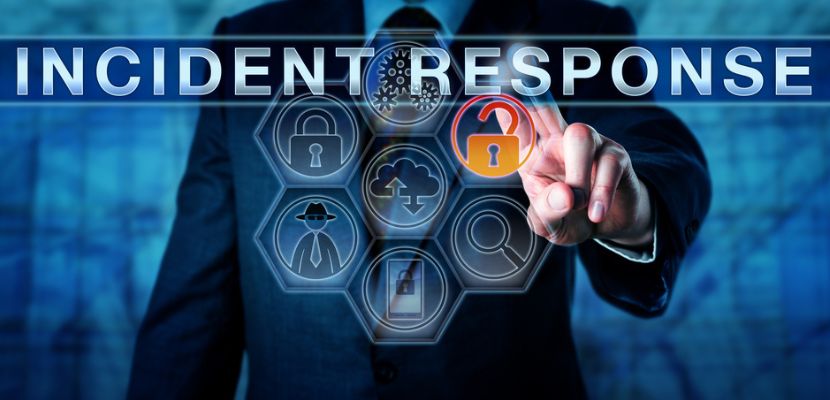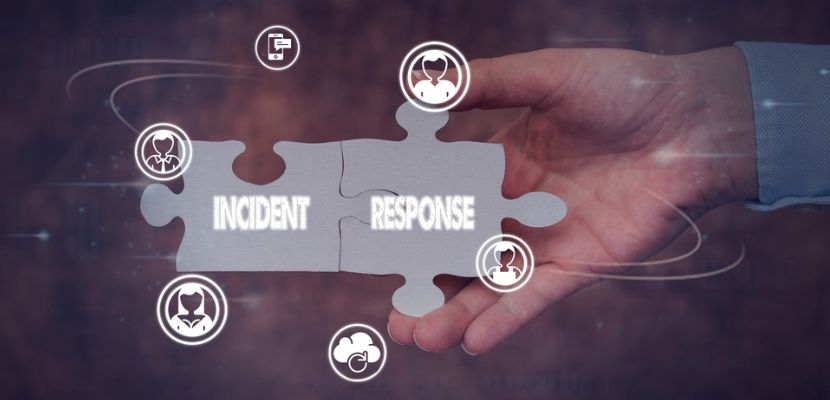Organizations today must put increasing effort into protecting their and their customers’ sensitive data, financial transactions, intellectual property, and the entire infrastructure of their operations. A robust and effective incident response plan is essential for countering sophisticated cyber threats that threaten an organization’s assets.
This article explains everything you need to know about security incident response plans, how to create one and their importance for the safety of your organization.

What Is a Cybersecurity Incident Response Plan (CSIRP)?
A cybersecurity incident response plan (CSIRP) is a set of procedures and guidelines that help organizations prepare for, detect, and respond to cybersecurity incidents. A cybersecurity incident response plan defines the roles and responsibilities of personnel, communication channels, and mitigation steps in the event of a cyber attack.
By implementing the protocols set out in a CSIRP, organizations can quickly recover from cyber attacks and data breaches, and return to normal operations without serious disruptions to business continuity. A robust plan also helps to prevent future breaches by including proactive security strategies.
Learn about the types of cyber attacks organizations face.
What Is the Cybersecurity Incident Response Process?
Responding to a cybersecurity incident involves several stages. This structured approach ensures that incidents are handled methodically and efficiently. This minimizes damage and reduces the time and costs of disaster recovery.
1. Preparation
Preparation is the basis of successful incident response. It begins with the drafting of a comprehensive incident response plan. This outlines roles, responsibilities, and procedures for addressing cyber threats. An effective CSIRP aims to address the organization’s specific vulnerabilities. It also addresses its security infrastructure, the type of data it handles, and the regulatory requirements mandated by the industry.
During this stage, organizations assemble a cyber incident response team (CIRT) that has the expertise and authority to act during a crisis. This team will contain personnel from various departments, such as IT, legal, public relations, and human resources. Team members are regularly trained and drilled to ensure utmost readiness in an emergency. This includes simulations of cyber attacks that check the organization’s systems and technology, incident detection, and management under pressure.
Organizations also need to invest in setting up the appropriate technology and systems for incident detection and management. These will include firewalls, intrusion detection systems (IDS), and security monitoring tools.
2. Identification
During the identification phase, the primary objective is to detect and accurately identify security incidents. The success of this stage depends on the organization’s ability to monitor and analyze its networks and systems for signs of unauthorized access, data breaches, or other malicious activities.
Effective identification requires sophisticated detection tools. This includes intrusion detection systems, security information and event management (SIEM) systems, and analytic tools that detect anomalies and suspicious behavior.
After a potential incident is detected, the security team must assess its nature and scope to determine the right approach to containment and mitigation. The team gathers and analyzes relevant data, such as logs, network traffic, and user activity to limit the incident's impact. Speedy and accurate incident identification supports the disaster recovery process and helps organizations to get back to operations.
3. Containment
Containment focuses on limiting the scope and impact of a cybersecurity incident. This step is divided into two types of strategies: short-term and long-term.
Short-term containment strategies aim to isolate the affected systems to prevent the spread of an attack. This can involve disconnecting infected computers from the network, blocking malicious traffic, or changing access credentials to prevent unauthorized access. These actions are crucial for minimizing the consequences on company systems.
On the other hand, long-term containment involves a more strategic and systematic approach to neutralizing the effects of a cyber attack. It involves patching vulnerabilities, updating or replacing compromised software, and reinforcing network security via network segmentation.
Maintaining business continuity during the containment stage often requires activating redundant systems or switching to backup operations. This approach ensures that business-critical functions remain operational while primary systems are being secured and cleaned of threats.
If your business requires high availability (HA) no matter what, phoenixNAP can help. Our high-availability solutions enable you to build HA systems, including global deployments, advanced replication, complete hardware and software redundancy, for a fraction of the cost.
4. Eradication
Eradication includes removing the threat from the organization’s systems by eliminating the root cause of the incident, such as malware, unauthorized access points, or exploited vulnerabilities. This process must be executed thoroughly to ensure the threat is completely neutralized and will not happen again.
This phase of incident response also includes an analysis of which systems and data were affected to understand how the breach occurred. By scrutinizing the attack vector and understanding the attacker’s movements within the network, organizations can pinpoint the weaknesses within the system.
Eradication is followed by strengthening the systems to prevent similar incidents in the future. This includes patching, updating IT security policies, boosting network defenses, and implementing more robust authentication practices. Done well, this stage of the process will help to improve the organization’s overall security posture and prevent similar threats in the future.
5. Recovery
The recovery stage focuses on restoring systems and returning services to normal functionality. After successful containment and eradication, organizations need to plan how to bring the systems back online safely. This includes restoring data from backups, repairing affected systems, and implementing additional security measures to protect against incidents in the future. During this process, it is crucial to monitor for any weak spots and possible reinfection.
Effective communication is essential during recovery, both internally (with stakeholders) and externally (with the public). Keeping all parties informed about the recovery process, the restoration timeline, and any ongoing risks will help to set expectations and maintain trust. It is also crucial for regulatory compliance and protecting the organization’s reputation.
6. Analysis and Reporting
Analysis and reporting are the concluding phases of the incident response process. They provide insights into the incident to ensure it does not happen again in the future. The incident response team examines the cause and the impact of the attack, as well as the quality of the incident response.
Reporting includes documenting these findings for internal use and, if necessary, submitting the reports to external entities such as regulatory bodies, law enforcement, or affected customers. These reports serve as valuable documents organizations can use to learn and improve their security practices and incident response plans.
How to Develop a Cybersecurity Incident Response Plan?

Creating a robust cybersecurity incident response plan involves several key stages, each designed to prepare an organization for the identification, containment, eradication, and recovery from the cyber incident. Here are the steps to follow when drawing up a CSIRP:
1. Conduct a Risk Assessment
Risk assessment is a necessary first step in drafting an incident response plan. It helps organizations understand the challenges they face and correctly identify which assets could be affected by a cyber incident, including hardware, software, data integrity, and the human element. As a part of this assessment, organizations also consider the current landscape of external threats, such as emerging social engineering tactics, evolving malware variants, and the spectrum of cybercriminal activities.
Once an organization identifies potential threats and vulnerabilities, it prioritizes them based on the potential impact. During prioritization, it is necessary to take into account the sensitivity of data and systems at risk and the legal and regulatory implications of cyber attacks. The outcome of this process informs the allocation of resources and efforts, ensuring that the team addresses the most significant risks first.
Risk assessment must be dynamic and include continuous monitoring and reassessment of risks as threats evolve rapidly and new vulnerabilities appear on a regular basis.
2. Define the Incident Response Team
Establishing an incident response team includes deciding who is responsible for implementing the incident response plan in case of a cyber attack. To ensure a comprehensive approach, this team needs to include personnel with diverse skills and roles, including IT security, legal, human resources, and public relations.
Each team member must have a clearly defined role, covering aspects such as initial response, technical analysis, communication, legal matters, etc. The head of the team is responsible for managing the implementation of the incident response plan and serves as the first point of contact for the rest of the team members. Furthermore, to be effective, the team should have the authority to make quick decisions and access the resources that will minimize the potential disruption.
Aside from having a dedicated in-house team, organizations must also establish relationships with external partners, such as cybersecurity firms, legal advisors, and public relations agencies, to ensure the adequate response to and mitigation of security incidents. This is particularly important in areas where specialized expertise is essential, such as forensic analysis of the root causes of the incident and the management of sensitive communications. Engaging external partners will enhance the organization’s ability to swiftly recover from the disaster and restore operational integrity and public trust.
3. Develop Incident Response Procedures
Developing an incident response plan is key for organizations to effectively respond to security incidents. These procedures should include detailed step-by-step actions for each phase of the incident response process, from identification to recovery and post-incident analysis.
When developing incident response procedures, it is fundamental to establish clear communication channels and protocols to follow during and after a security incident. These protocols specify who is informed at which stage of the incident and outline the process of communication with law enforcement, regulatory bodies, and the media.
Training on the implementation of these procedures and conducting simulation exercises are vital for the validation and refinement of these measures. Moreover, these procedures should be clearly documented, accessible, and regularly reviewed and updated to incorporate new policies and adapt to emerging threats.
4. Establish Notification and Escalation Protocols
Detailing notification and escalation processes ensures that stakeholders are informed about security incidents in a timely manner and that incidents are escalated appropriately for an effective incident response. These protocols define how information about the incidents is shared and with whom to prevent information silos and ensure that decision-makers have the information necessary for responding to the situation. Clear guidelines avoid confusion and response delays, streamlining the incident response process.
Escalation protocols dictate how and when incidents are escalated based on their severity, complexity, and potential impact. They ensure that the most serious events get the attention of senior management or the additional support of external experts. Furthermore, they outline the process of engaging law enforcement, regulatory bodies, and other third parties.
Staff should be trained and drilled in notification procedures and escalation protocols. This ensures that all key personnel can act quickly and confidently if an event occurs.
5. Create a Communication Plan
Communication plans ensure that stakeholders are adequately informed about an ongoing security incident. They identify which team members, customers, partners, and regulators should be notified to maintain transparency and manage expectations. By tailoring these plans to specific scenarios and providing predefined templates, organizations can significantly reduce response times. This helps them avoid the spread of conflicting information.
Communication plans are important for internal communication as well. They ensure that response teams, management, and all employees are properly informed about the nature and scope of the security incident. These plans also contain protocols regarding how to update stakeholders as the incident evolves, aiming to minimize panic and aid decision-making.
6. Integrate with Business Continuity and Disaster Recovery Plans
Integrating the incident response plan with business continuity and disaster recovery plans is essential for ensuring an organization’s resilience in the face of a cyber attack.
Business continuity plans (BCPs) aim to prevent downtime and keep business critical functions running. They achieve this by identifying the personnel, processes, and technologies that are essential for maintaining operations. By aligning incident response plans with business continuity plans, organizations can activate alternative processes and systems. This helps minimize financial and reputational damage.
Disaster recovery plans (DRPs) focus on restoring IT infrastructure and services after a disruption has occurred. When integrated with incident response plans, they ensure a coordinated approach to recovering compromised systems, data, and networks. This includes previously established recovery point objectives (RPOs) and recovery time objectives (RTOs).
7. Identify and Implement Necessary Tools and Technologies
Organizations must determine the exact tools and technologies they require to successfully combat cyber attacks. The most common technologies in use for this purpose are:
- Intrusion detection systems (IDS).
- Security information and event management (SIEM) systems.
- Advanced endpoint detection and response (EDR) solutions.
These systems provide a comprehensive overview of the organization’s security infrastructure and enable real-time monitoring, alerting, and analysis of potential security incidents. However, these tools need to be integrated seamlessly into the existing IT infrastructure to provide a layered and robust defense structure.
Incident response tools also include automation and orchestration platforms that streamline response activities and reduce the time and resources required for resolving security issues. It is crucial for these tools to easily integrate into the existing infrastructure for full security coverage.
8. Train and Educate Personnel
Staff is the first line of defense against cyber threats, and organizations should invest in training and educating their employees on how to prevent potential incidents and respond to them if they do occur.
Cybercriminals have developed sophisticated ways of manipulating people’s psychological tendencies to execute social engineering attacks that can have devastating effects. This is why it is important to perform regular security awareness training and teach staff how to recognize malicious attempts and how to act and communicate in the midst of an ongoing security incident.
Education must also include specialized training in how to use cybersecurity tools and technologies. To be effective, the security team must have thorough knowledge of the capabilities and limitations of intrusion detection systems, SIEM systems, endpoint protection solutions, and other tools. Furthermore, since these technologies are always evolving, staff should periodically revise their knowledge and grow their skills.
9. Test, Review, Update
Testing, reviewing, and updating the incident response plan is essential for its effectiveness. Organizations should perform penetration testing by simulating real-life cyber attacks to ensure their security protocols are efficient and effective. These tests also highlight the strengths and weaknesses of plans and policies and provide useful feedback that helps refine and strengthen the plan.
Reviewing and updating an incident response plan is a continuous process that should occur at least once a year or after any significant changes to the company’s infrastructure, technology, or processes. Changes in regulation and compliance requirements should also prompt reviews and updates to ensure the organization meets its legal obligations.
10. Consider Legal and Regulatory Implications
Incident response plans are not complete without considering the legal and regulatory requirements of the specific industry the organization operates is. All organizations must understand their obligations under laws such as GDPR, HIPAA, or the PCI DSS standards in order to protect their customers’ sensitive data. Under these mandates, organizations must report all breaches to their respective regulatory bodies and the individuals affected by them. Failure to comply results in fines, legal actions, and reputational damage for the company.
In addition to compliance, organizations must also preserve evidence of cyber attacks for a potential legal investigation. This includes establishing protocols for collecting and preserving digital evidence for further forensic analysis and admissibility in court.
Why Do You Need a Cybersecurity Incident Response Plan?

There are a variety of reasons why organizations should have incident response plans, including:
- Minimizing the impact of breaches. Incident response plans help organizations to contain and mitigate the effects of cybersecurity incidents and reduce damage to data and assets.
- Enhancing recovery time. Organizations can restore operations back to normal more quickly with an incident response plan in place.
- Improving incident detection. Incident response plans contain methods for continuous monitoring and swift detection of potential breaches before they cause damage.
- Ensuring regulatory compliance. Successful incident response plans comply with regulatory standards to avoid potential fines and legal penalties.
- Preserving reputation. Effective incident response plans mitigate negative publicity as a result of cyber incidents, preserving the customer trust.
- Enabling informed decision-making. Incident response plans assist teams in making prudent and informed decisions during a crisis.
- Providing continuous improvement. These plans include in-depth analysis post-incident, helping organizations refine their security policies and learn from previous mistakes.
- Reducing financial losses. Incident response plans aim to help organizations minimize the duration and impact of security incidents, which saves money.
- Supporting business continuity. Incident response plans ensure that organizations restore regular operations as soon as possible after a breach.
- Building stakeholder confidence. Incident response plans show customers, investors, and partners that the organization is able to protect their sensitive information and assets from a cyber attack.
Security Incident Response Plan - Your Shield Against Digital Disasters
Having an incident response place is imperative for organizations operating in the digital landscape. It ensures complete protection of sensitive data and systems and quick restoration to normal operations in case of a cybersecurity incident.



